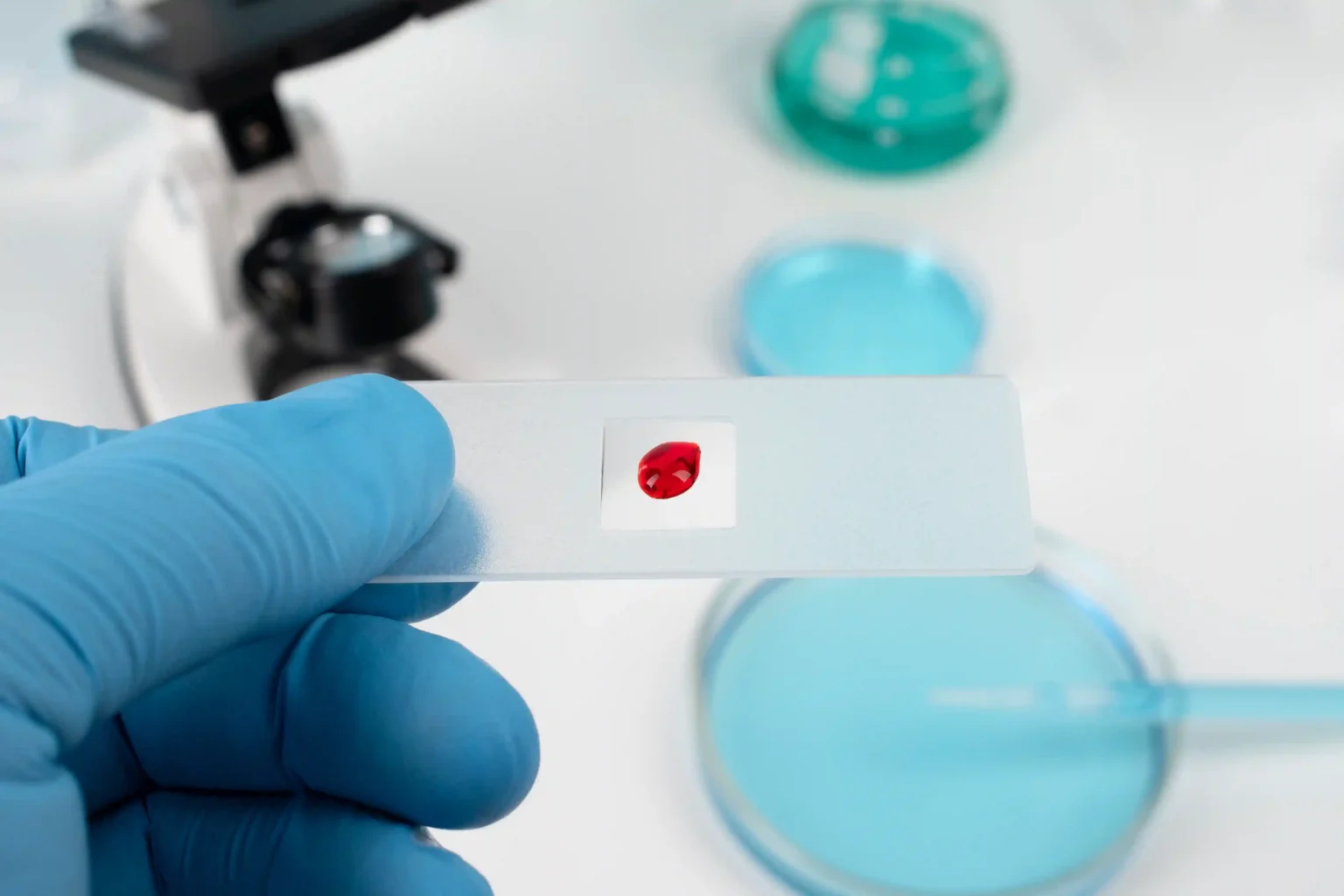
Managing blood sugar is essential for overall health, especially for individuals with diabetes. The Hemoglobin A1C test is a critical measure of long-term blood sugar control. Unlike daily blood glucose tests that show blood sugar levels at specific moments, the A1C test offers a broader view. It reflects average blood sugar levels over the past two to three months.
This guide will explore what Hemoglobin A1C is, how it is measured, what its results indicate, and why it’s an invaluable tool for managing diabetes.
What Does Hemoglobin A1C Mean?
Hemoglobin A1C, often abbreviated as HbA1C, is a form of hemoglobin found in red blood cells. When glucose enters the bloodstream, it attaches to hemoglobin, forming glycated hemoglobin. The more glucose present in the blood, the higher the level of HbA1C.
Over time, the amount of glycated hemoglobin increases, reflecting average blood sugar levels over the lifespan of red blood cells (approximately 120 days). This makes HbA1C a reliable indicator of long-term blood sugar management.
Key Facts About Hemoglobin A1C
- Normal HbA1C Level: Below 5.7%. This is considered a healthy range for most people.
- Prediabetes Range: Between 5.7% and 6.4%. This indicates an increased risk of developing diabetes.
- Diabetes Range: 6.5% or higher. A level this high suggests that blood sugar is not well-controlled.
Implications of HbA1c Results (A1C Ranges)
| A1C Range | Category | Implications |
|---|---|---|
| Below 5.7% | Normal | Low risk of diabetes, good glucose management |
| 5.7% - 6.4% | Prediabetes | Elevated risk, lifestyle adjustments recommended |
| 6.5% or higher | Diabetes | Consistently high glucose; treatment adjustments required |
- How HbA1C Reflects Blood Sugar: It measures the percentage of hemoglobin in your blood that is coated with sugar. It shows the average blood sugar level over the last 2-3 months.
- Why Regular Testing is Important: HbA1C levels give a long-term view of blood sugar control, unlike daily glucose tests that only show short-term fluctuations.
- Target HbA1C Level: For people with diabetes, a common target is below 7%. However, individual targets may vary based on health conditions and age.
Why Glycated Hemoglobin Matters?
- Shows Long-Term Control: HbA1C tests give a view of blood sugar levels over 2-3 months. It shows overall trends, not just daily spikes.
- Highlights Blood Sugar Trends: It reveals if blood sugar is consistently high. Short-term changes don’t affect HbA1C.
- Indicates Risk of Complications: High HbA1C levels mean prolonged exposure to elevated blood sugar. This can damage organs, blood vessels, and nerves.
- Tracks Diabetes Management: HbA1C tests measure how well blood sugar is controlled. It reflects the success of medications, diet, and exercise.
- Prevents Health Issues: Keeping HbA1C in check lowers the risk of serious complications. It helps avoid heart disease, kidney problems, and nerve damage.
- Early Warning for Prediabetes: Slightly high HbA1C levels signal prediabetes. Early action can prevent diabetes from developing.
- Reliable Measure: Unlike daily glucose tests, HbA1C tests give a broader view of blood sugar. It’s a key tool for managing diabetes.
Why is the Hemoglobin A1C Test Important?
The HbA1C test plays a crucial role in diagnosing and managing diabetes. It provides insights into blood sugar trends that daily glucose monitoring cannot reveal. Here’s why it matters:
- Early Diagnosis of Diabetes: HbA1C tests can detect blood sugar issues before symptoms appear.
- Evaluation of Treatment Effectiveness: Helps healthcare providers assess whether diet, medication, or lifestyle changes are controlling diabetes effectively.
- Prevention of Complications: High HbA1C levels over time can lead to complications like heart disease, kidney damage, and neuropathy. Regular monitoring can reduce these risks.
Common Myths About Hemoglobin A1C Testing
There are several misconceptions surrounding Hemoglobin A1C testing. Here are some common myths:
1. Myth: Hemoglobin A1C Testing is Only for People with Diabetes
Fact: A1C testing is also used to assess the risk of diabetes in people with prediabetes or those at risk. Non-diabetics can benefit from A1C testing to monitor long-term blood sugar levels.
Fact: A1C testing is also used to assess the risk of diabetes in people with prediabetes or those at risk. Non-diabetics can benefit from A1C testing to monitor long-term blood sugar levels.
2. Myth: The A1C Test is Only for Monitoring Diabetes
Fact: A1C tests also show the risk of complications from diabetes, such as heart disease, eye, and foot conditions.
Fact: A1C tests also show the risk of complications from diabetes, such as heart disease, eye, and foot conditions.
3. Myth: A1C Test Results Can Fluctuate Even within a Day
Fact: The A1C test measures average blood sugar over two to three months. It is not impacted by daily spikes or drops in blood sugar.
Fact: The A1C test measures average blood sugar over two to three months. It is not impacted by daily spikes or drops in blood sugar.
4. Myth: Fasting is required before an A1C test
Fact: Fasting is not necessary for an A1C test since it measures long-term glucose control rather than immediate blood sugar levels.
Fact: Fasting is not necessary for an A1C test since it measures long-term glucose control rather than immediate blood sugar levels.
5. Myth: Hemoglobin A1C Levels Can Be Lowered Quickly
Fact: A1C reflects your average blood sugar over the past 2 to 3 months, so daily variations do not affect the result.
Fact: A1C reflects your average blood sugar over the past 2 to 3 months, so daily variations do not affect the result.
6. Myth: All A1C Tests Provide the Same Level of Accuracy
Fact: Not all A1C tests are made the same. At-home A1C tests are generally considered less accurate than laboratory tests. Quality is not streamlined across OTC tests, and some may provide inaccurate readings. However, advancements in microfluidic technology will improve the accuracy of rapid A1C testing, making at-home options more reliable in the near future.
Fact: Not all A1C tests are made the same. At-home A1C tests are generally considered less accurate than laboratory tests. Quality is not streamlined across OTC tests, and some may provide inaccurate readings. However, advancements in microfluidic technology will improve the accuracy of rapid A1C testing, making at-home options more reliable in the near future.
7. Myth: The A1C Test is the Only Way to Measure Diabetes Control
Fact: A1C is important, but not the only measure. Daily blood glucose monitoring is essential for understanding short-term blood sugar control.
Fact: A1C is important, but not the only measure. Daily blood glucose monitoring is essential for understanding short-term blood sugar control.
These myths can confuse people. Understanding the truth helps better manage diabetes and overall health.
How is Hemoglobin A1C Measured?
The test is simple and does not require fasting, making it convenient for most patients. Here’s how it works:
1. Blood Sample Collection:
A healthcare provider collects a small blood sample, typically from a vein in your arm.
2. Lab Analysis: The sample is analyzed to determine the percentage of glycated hemoglobin.
3. Result Interpretation: Results are expressed as a percentage.
2. Lab Analysis: The sample is analyzed to determine the percentage of glycated hemoglobin.
3. Result Interpretation: Results are expressed as a percentage.
Comparison With Regular Glucose Tests
| Aspect | Regular Glucose Test | HbA1C Test |
|---|---|---|
| Timing | Measures blood sugar at a specific time | Reflects long-term blood sugar control over 2-3 months |
| Preparation | Often requires fasting | No fasting needed |
| Use | Identifies sudden drops (hypoglycemia) or spikes (hyperglycemia) in blood sugar, enabling prompt intervention | Diabetes diagnosis, Risk assessment for complications, Monitors treatment efficacy |
What Causes High HbA1C Levels?
High HbA1C levels are a result of prolonged elevated blood sugar. Factors include:
- Poor Diet: Eating too much sugar and refined carbs raises blood sugar. A diet high in processed foods also impacts blood sugar control.
- Lack of Exercise: Not being active reduces insulin sensitivity. This makes it harder to control blood sugar levels.
- Ineffective Treatment: If diabetes treatment isn’t working, blood sugar stays high. Adjustments to medication may be needed.
- Stress: Chronic stress raises blood sugar. Stress hormones like cortisol make it harder to control blood sugar.
- Insulin Resistance: The body stops responding well to insulin. This results in high blood sugar and higher HbA1C.
- Poor Sleep: Lack of sleep or sleep disorders raise blood sugar. Sleep issues interfere with glucose control.
- Medications: Certain medications, like steroids, can raise blood sugar. This leads to higher HbA1C levels.
- Age: As you age, glucose processing slows. This can cause higher HbA1C levels.
- Health Conditions: Diseases like PCOS and thyroid issues can increase blood sugar. These conditions can raise HbA1C.
- Alcohol: Drinking too much alcohol can cause blood sugar fluctuations. This affects HbA1C levels over time.
What happens when your A1C is high?
Chronically elevated HbA1C can lead to significant health issues.
| Risk | Description |
|---|---|
| Fatigue | Elevated blood sugar can cause tiredness. The body struggles to use energy efficiently. |
| Nerve Damage (Neuropathy) | Pain, tingling, and numbness, especially in extremities. |
| Cardiovascular Disease | Increased risk due to damage to blood vessels. |
| Vision Problems | High HbA1C can damage blood vessels in the eyes, leading to vision loss or blindness. |
| Kidney Damage (Nephropathy) | Reduced kidney function, possibly leading to failure. |
| Gum Disease | Poor blood sugar control can cause swollen gums and tooth loss. Gum infections become more common. |
| Erectile Dysfunction | High blood sugar can cause nerve and blood vessel damage, leading to erectile dysfunction. |
| Slow Wound Healing | Elevated HbA1C reduces the body’s ability to heal wounds quickly. Small cuts can take longer to recover. |
| Increased Infections | High glucose levels promote bacteria and fungi, raising the risk of skin, urinary tract, and other infections. |
| Skin Infections | High blood sugar weakens the immune system, making it easier for infections to develop. |
| Stroke | High HbA1C damages blood vessels, increasing the risk of stroke. Blood flow to the brain becomes restricted. |
| Digestive Issues | High blood sugar affects digestion. Nerve damage can cause bloating, diarrhea, and other stomach issues. |
| Hearing Loss | Elevated HbA1C may cause inner ear damage, leading to hearing problems over time. |
How to Lower Elevated HbA1C Levels?
Lowering A1C levels requires a combination of lifestyle changes and regular monitoring/management as recommended by a healthcare provider. Key tips for lowering levels include:
- Adopting a balanced diet rich in whole grains, vegetables, and lean proteins.
- Incorporating regular physical activity, like walking, cycling, or swimming.
- Sticking to prescribed diabetes medications and monitoring blood sugar levels through a combination of A1C and CGM testing.
Importance of Lifestyle in Managing HbA1C
- Diet and Exercise: A balanced diet with whole grains, lean proteins, and vegetables can stabilize blood sugar. Regular physical activity, like walking or cycling, helps improve insulin sensitivity.
- Medication Management: Proper adherence to prescribed treatments, including insulin or oral medications, is essential for control.
- Regular Monitoring: Frequent testing ensures that adjustments can be made promptly, avoiding long-term complications.
- Stress Reduction: Techniques like mindfulness, yoga, or deep breathing exercises can lower stress levels and improve blood sugar control.
Factors That Affect HbA1C Levels
Certain conditions can influence HbA1C accuracy, including:
- Anemia or Blood Disorders: Can lead to lower or skewed results.
- Pregnancy: Hormonal changes can lead to increased plasma volume and altered red blood cell turnover
- Ethnic Background: Some populations, such as Southeast Asian descent, may naturally have slightly higher levels.
- Kidney Disease: Kidney problems can lead to inaccurate HbA1C results. Poor kidney function affects the lifespan of red blood cells.
- Chronic Blood Loss: Frequent blood loss can affect the accuracy of HbA1C tests. It may alter red blood cell turnover, leading to misleading results.
- Vitamin Deficiencies: Deficiencies in certain vitamins, like B12 or folate, can interfere with HbA1C levels. These deficiencies affect red blood cell production.
Long-Term Benefits of Managing HbA1C
- Improved Heart Health: Reduces risk of cardiovascular disease.
- Better Nerve Function: Prevents neuropathy and associated discomfort.
- Kidney Protection: Lowers chances of kidney failure.
- Enhanced Vision Health: Prevents diabetic retinopathy.
- Overall Quality of Life: Supports energy levels and daily functionality.
The Hemoglobin A1C test is an invaluable tool for diagnosing and managing diabetes. By understanding your HbA1C level and taking proactive steps-such as adopting a healthy lifestyle, managing stress, and following your treatment plan-you can reduce the risk of complications and improve overall well-being.
Regular testing and consultation with a healthcare provider are essential for effective blood sugar management. Remember, small changes can lead to significant improvements in your health.
FAQs About Hemoglobin A1C
1. What is a normal hemoglobin A1C level?
Normal hemoglobin A1C levels typically range from 4% to 5.6%. A level between 5.7% and 6.4% is considered prediabetes, while 6.5% or higher suggests diabetes.
2. How can I get my A1C down quickly?
To lower A1C quickly, focus on improving your diet by eating fewer carbs, increasing physical activity, losing weight, and managing stress. You may also need to adjust medications under your doctor’s guidance.
3. What is a good A1C for my age?
A good A1C is generally below 5.7%, regardless of age. However, it’s important to consult with your doctor for personalized advice.
4. Why would your hemoglobin A1C be high?
High hemoglobin A1C levels are usually a sign of poorly controlled blood sugar. This can be caused by factors like poor diet, lack of exercise, stress, or insufficient diabetes medication.
5. Why are HbA1C tests important?
Regularly monitoring your A1C levels provides a comprehensive view of long-term glucose control, which can also help with maintaining long-term health. Keep in mind that factors like anemia or recent blood transfusions may affect results, and it’s important to get accurate results regularly to effectively monitor your A1C levels.







